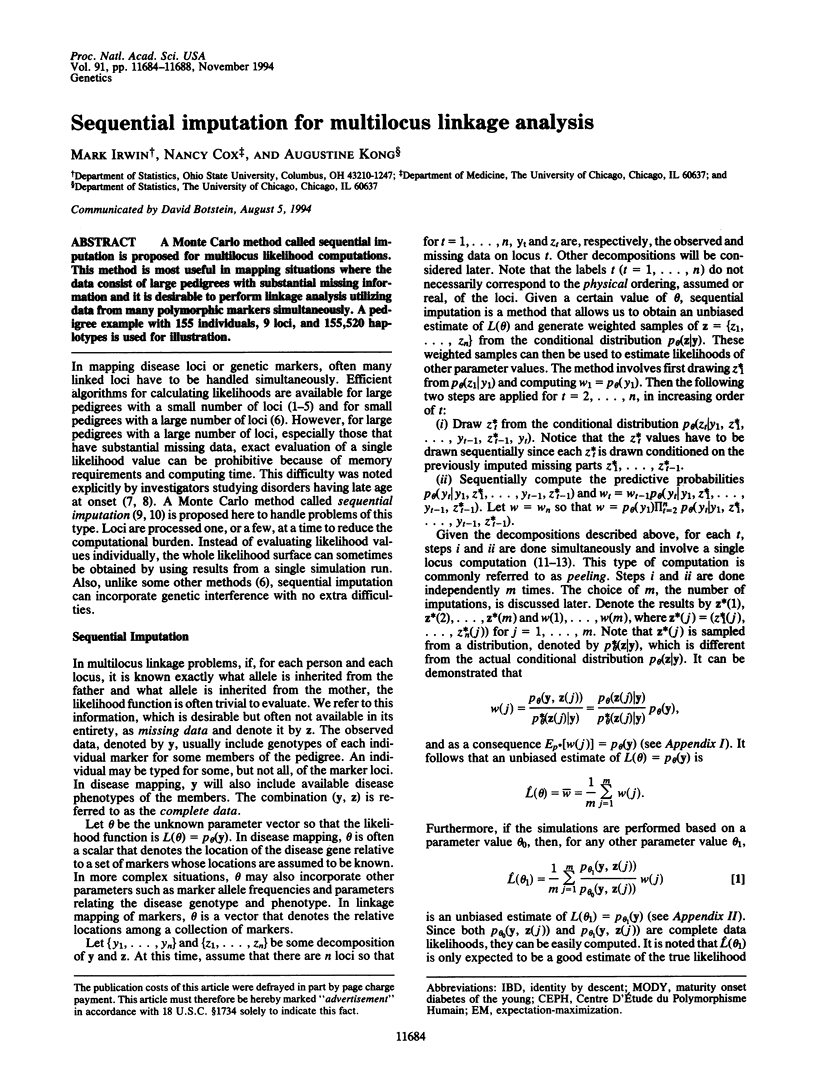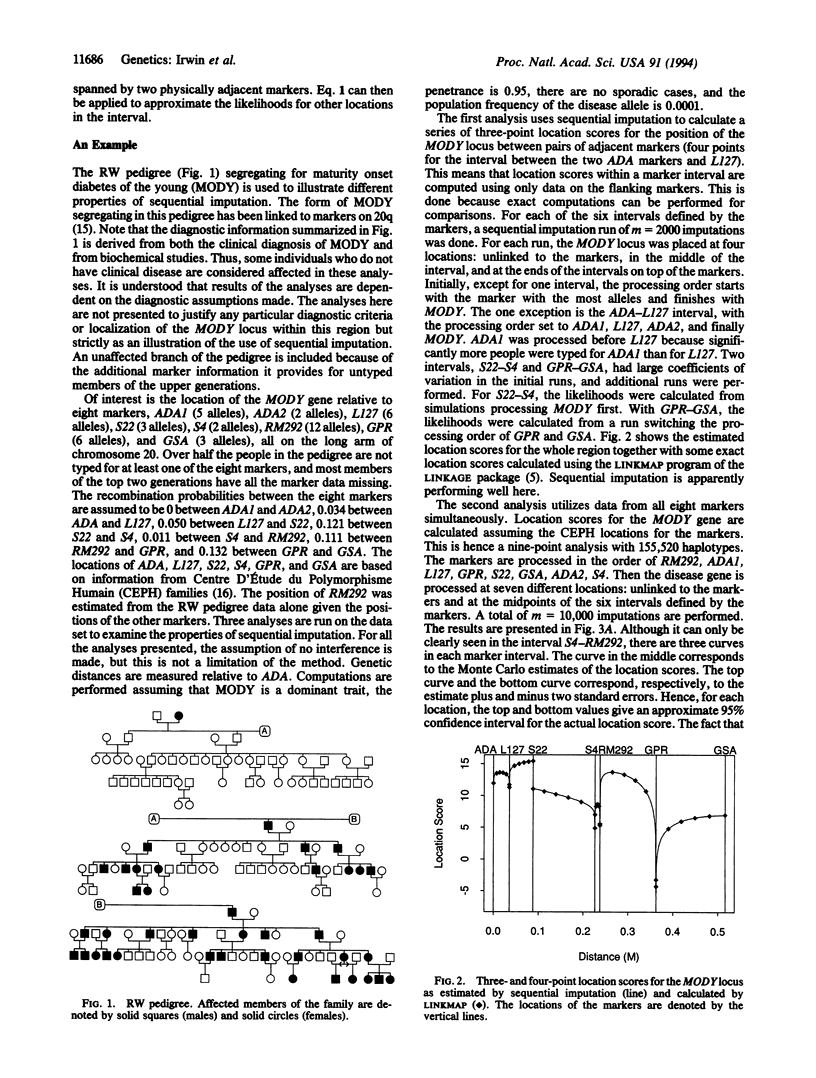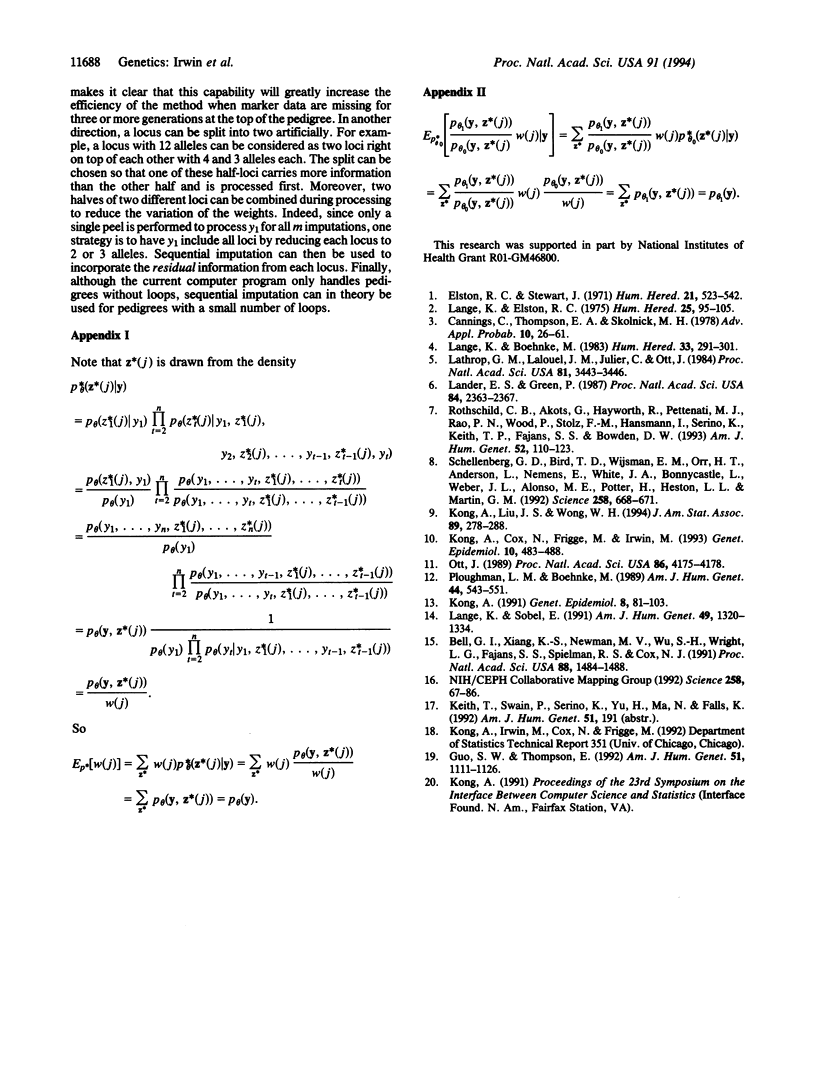Abstract
A Monte Carlo method called sequential imputation is proposed for multilocus likelihood computations. This method is most useful in mapping situations where the data consist of large pedigrees with substantial missing information and it is desirable to perform linkage analysis utilizing data from many polymorphic markers simultaneously. A pedigree example with 155 individuals, 9 loci, and 155,520 haplotypes is used for illustration.
Full text
PDF




Selected References
These references are in PubMed. This may not be the complete list of references from this article.
- Bell G. I., Xiang K. S., Newman M. V., Wu S. H., Wright L. G., Fajans S. S., Spielman R. S., Cox N. J. Gene for non-insulin-dependent diabetes mellitus (maturity-onset diabetes of the young subtype) is linked to DNA polymorphism on human chromosome 20q. Proc Natl Acad Sci U S A. 1991 Feb 15;88(4):1484–1488. doi: 10.1073/pnas.88.4.1484. [DOI] [PMC free article] [PubMed] [Google Scholar]
- Elston R. C., Stewart J. A general model for the genetic analysis of pedigree data. Hum Hered. 1971;21(6):523–542. doi: 10.1159/000152448. [DOI] [PubMed] [Google Scholar]
- Guo S. W., Thompson E. A. A Monte Carlo method for combined segregation and linkage analysis. Am J Hum Genet. 1992 Nov;51(5):1111–1126. [PMC free article] [PubMed] [Google Scholar]
- Kong A., Cox N., Frigge M., Irwin M. Sequential imputation and multipoint linkage analysis. Genet Epidemiol. 1993;10(6):483–488. doi: 10.1002/gepi.1370100626. [DOI] [PubMed] [Google Scholar]
- Kong A. Efficient methods for computing linkage likelihoods of recessive diseases in inbred pedigrees. Genet Epidemiol. 1991;8(2):81–103. doi: 10.1002/gepi.1370080203. [DOI] [PubMed] [Google Scholar]
- Lander E. S., Green P. Construction of multilocus genetic linkage maps in humans. Proc Natl Acad Sci U S A. 1987 Apr;84(8):2363–2367. doi: 10.1073/pnas.84.8.2363. [DOI] [PMC free article] [PubMed] [Google Scholar]
- Lange K., Boehnke M. Extensions to pedigree analysis. V. Optimal calculation of Mendelian likelihoods. Hum Hered. 1983;33(5):291–301. doi: 10.1159/000153393. [DOI] [PubMed] [Google Scholar]
- Lange K., Elston R. C. Extensions to pedigree analysis I. Likehood calculations for simple and complex pedigrees. Hum Hered. 1975;25(2):95–105. doi: 10.1159/000152714. [DOI] [PubMed] [Google Scholar]
- Lange K., Sobel E. A random walk method for computing genetic location scores. Am J Hum Genet. 1991 Dec;49(6):1320–1334. [PMC free article] [PubMed] [Google Scholar]
- Lathrop G. M., Lalouel J. M., Julier C., Ott J. Strategies for multilocus linkage analysis in humans. Proc Natl Acad Sci U S A. 1984 Jun;81(11):3443–3446. doi: 10.1073/pnas.81.11.3443. [DOI] [PMC free article] [PubMed] [Google Scholar]
- Ott J. Computer-simulation methods in human linkage analysis. Proc Natl Acad Sci U S A. 1989 Jun;86(11):4175–4178. doi: 10.1073/pnas.86.11.4175. [DOI] [PMC free article] [PubMed] [Google Scholar]
- Ploughman L. M., Boehnke M. Estimating the power of a proposed linkage study for a complex genetic trait. Am J Hum Genet. 1989 Apr;44(4):543–551. [PMC free article] [PubMed] [Google Scholar]
- Rothschild C. B., Akots G., Hayworth R., Pettenati M. J., Rao P. N., Wood P., Stolz F. M., Hansmann I., Serino K., Keith T. P. A genetic map of chromosome 20q12-q13.1: multiple highly polymorphic microsatellite and RFLP markers linked to the maturity-onset diabetes of the young (MODY) locus. Am J Hum Genet. 1993 Jan;52(1):110–123. [PMC free article] [PubMed] [Google Scholar]
- Schellenberg G. D., Bird T. D., Wijsman E. M., Orr H. T., Anderson L., Nemens E., White J. A., Bonnycastle L., Weber J. L., Alonso M. E. Genetic linkage evidence for a familial Alzheimer's disease locus on chromosome 14. Science. 1992 Oct 23;258(5082):668–671. doi: 10.1126/science.1411576. [DOI] [PubMed] [Google Scholar]


